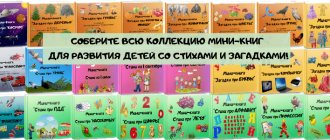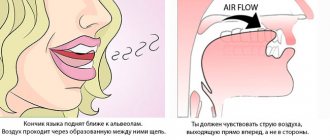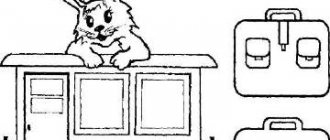The order of phonetic parsing of a word
The word is often pronounced completely differently from how it is written. For example: we write “milk”, “chocolate”, but pronounce “malako”, “jackalat”. Phonetic analysis of a word, in other words, sound analysis, helps to understand the difference between the sounds we pronounce and the letters we write. The sound recording of a word is made using transcription.
Let's listen to Academician Sound Expert on how to do this work correctly.
Examples from Academician Sound Scientist:
It is important to correctly write the word in transcription:
- vowels and consonants in a strong position are written as they are heard;
- emphasis must be placed;
- sounds in a weak position are recorded as they are pronounced;
- the softness of consonants is indicated by a comma to the right above the letter.
Methods for setting sounds [S], [Z], [C] step by step
As diverse as the defects in pronouncing the sounds [S], [Z], [Ts] are, the ways to overcome them are just as diverse. To produce whistling sounds, complex and precise movements of the tongue are required, which involve the tip of the tongue, the lateral edges of the tongue, and the back of the tongue. Also necessary are precise movements of the lips (in a smile), the lower jaw (barely lowered) and the presence of an air stream (sufficiently strong and moving in the middle of the tongue). To develop the necessary movements of the lips and tongue, a series of articulation exercises should be performed.
Lip exercises
"Smile"
. Smile so that the upper and lower teeth are visible, hold this position for 5-7 seconds.
"Tube"
. Extend lips with a tube:
1st option - pronounce the sound [U] for a long time without using your voice;
2nd option - pull your lips slightly forward, as if forming a square. The teeth are closed.
"Doors Open"
. Slowly open your mouth until there is a distance of 10-15 mm between the upper and lower teeth, hold your lips in the “Smile” position.
"Bunny"
. Smile so that your upper and lower teeth are visible, raise your upper lip (wrinkle your nose), and lower it back into place.
Lower your lower lip and open your lower teeth. Lips and teeth are closed. Repeat 5-7 times.
Gymnastics for the tongue
"Pancake"
. Place a wide, relaxed tongue on the lower lip.
Make sure that the lower lip does not tense. The upper teeth should be exposed (that is, the “Smile” position is maintained). If the tongue does not take the desired shape, it is recommended to do a passive massage, pronounce syllables with the tongue sticking out between the lips, for example “ba-ba-ba”.
Upon achieving success, make your tongue wide without pronouncing these syllables and blow with a narrow cold stream of air until a groove is formed along the midline of the tongue.
"Swing"
. Raise your wide tongue over your upper teeth and then lower it behind your lower teeth. Perform the exercise counting 8-10 times.
"Let's brush our teeth"
. Smile, show your teeth, open your mouth slightly and “clean” your lower teeth with the tip of your tongue, first moving your tongue from side to side, then from bottom to top.
"Slide"
. Smile, show your teeth, open your mouth, place the tip of your tongue behind your lower incisors, pushing the middle part of the back of your tongue forward (“built a slide”).
"Monkey"
. Bite the side edges of the tongue (perform the “Gorka” exercise) and, holding the tip of the tongue behind the lower teeth, bite the side edges of the tongue on the right and left (you can pronounce “ey-ey-ey”). If this doesn’t work, then pronounce the sound “i-i-i”, stretching your lips as much as possible and holding the tip of your tongue behind your lower teeth.
"Pussy is angry"
. Smile, show your teeth, open your mouth, place the tip of your tongue behind your lower incisors, arch your back and stroke it with your upper teeth. In this case, you need to make sure that the lower teeth do not move forward.
“High slide - low slide”
. Lower the tip of the tongue behind the lower teeth, pushing the middle part of the back of the tongue forward (“high slide”). Holding the tip of your tongue behind your teeth, pull the middle part of the back of your tongue deep into your mouth (“low slide”). Repeat 3-4 times.
Breathing exercises
"Breeze"
. Simply blow through closed lips, controlling the stream of exhaled air using a strip of paper brought to your mouth, a piece of cotton wool suspended on a thread, or simply by feeling the stream on your hand brought to your mouth.
"Put the ball into the goal"
. Stretch your lips forward with a tube and blow for a long time onto a cotton ball (lying on the table in front of the child), driving it between two cubes.
“Who will kick the ball further?”
Smile, place the wide front edge of the tongue on the lower lip, as if pronouncing the sound [F] for a long time, blow the cotton wool onto the opposite edge of the table. The lower lip should not be pulled over the lower teeth. Make sure that the child does not puff out his cheeks and pronounces the sound [F], not [X].
"Singing Bubble"
. The exercise is done in front of a mirror with the tongue stuck wide between the lips, its lateral edges adjacent to the corners of the mouth. A longitudinal groove should form in the middle of the tongue. Holding the vial (test tube) vertically, you should bring its hole to the middle part of the front edge of the tongue. If, at the moment of blowing, a groove is formed along the tongue, along which an air stream rushes, then when the bubble (test tube) is brought to the tongue, a strong noise should be heard, which indicates the correct alignment of the tongue.
"Focus"
. Smile, open your mouth slightly, place the wide front edge of your tongue on your upper lip so that its side edges are pressed and a groove is formed in the middle, and blow off the cotton wool placed on the tip of your nose. The air should go in the middle of the tongue, then the fleece will fly up.
Pronouncing the sound [S]
- the lips slightly stretch into a smile, except in those cases when the subsequent phonemes are the vowels [O] and [U], which leads to anticipatory rounding of the lips;
- the teeth are either compressed or brought together, leaving only a narrow gap (about 1-2 mm);
- the tip of the tongue rests on the gums of the lower incisors, its back is curved, and the lateral edges are adjacent to the upper molars;
- along the tongue, in its middle, a groove is formed, which at the alveoli opens outwards with a narrow round hole;
- the soft palate is raised and closes the passage of air into the nasal cavity;
- The vocal cords are open and freely allow exhaled air to pass into the pharyngeal and oral cavities. The air stream is narrow, cold, strong.
The baby does not pronounce whistling sounds, when should we start combating this phenomenon?
If you wait until the age of five to take your child to a speech therapist, you may be late, the child will develop incorrect pronunciation, and it will be increasingly difficult for him to change anything. It doesn't take an expert to understand that babies need to create a trigger to begin pronouncing sounds correctly. And it’s better to do this at 4 years old. Many parents cope with their child’s speech defects themselves, without the participation of speech therapists.
If the baby does not have serious speech disorders, then producing whistling sounds will not be difficult. All you have to do is follow the recommendations of this article so that your child will soon delight you with a ringing Z and other correctly placed sounds. Once this skill has been achieved once, your task will be to consolidate the skill, that is, to bring it to the level of automaticity.
If your baby’s sounds are impaired, he speaks incomprehensibly, or only you can understand it, you cannot ignore a speech therapist. It would be impossible to do without his participation. The earlier you come to your first conversation with a speech therapist, the faster the results will be achieved and consolidated.
All the following exercises will be useful not only for kids, but also for school-age children, and even for parents themselves, since articulatory gymnastics at any age develops the speech apparatus, makes it more pliable, flexible, teaches how to control it perfectly, and how to control it according to at your own discretion.
Step-by-step work is the most important thing in the fight against poor pronunciation. How to competently approach the issue of setting sounds and what you need to understand for yourself:
- Awareness and understanding of all movements of the organs of the speech apparatus that are needed to pronounce a certain sound.
- The emergence of the correct sound.
- Consolidating the given sound in the child’s spoken speech, both in individual syllables and in entire phrases and rhymes.
Number of letters and sounds in words
Guys, using the color scheme of the word, it will not be difficult for you to characterize each sound, count the number of letters and sounds.
You already know from previous lessons that words may have a discrepancy in the number of sounds and letters. Let's consider in what cases this happens.
- If the word contains a soft sign b: mouse, finger. Let's write down the transcriptions of words, count the number of letters and sounds in the words: [mouse] (4 letters, 3 sounds), [pal'ch'ik] (7 letters, 6 sounds). There are fewer sounds than letters.
- If a word contains iotated letters, which are formed by two sounds: a consonant [th] and vowels: [a], [u], [o] [e]. Example: fir tree [y'olka] (4 letters, 5 sounds), south [y'uk] (2 letters, 3 sounds), berry [y'agada] (5 letters, 6 sounds). These examples have more sounds than letters.
Apart from b, the letter b has no sound. But a hard sign does not change the number of sounds in words. It is followed by iotated vowels, which have 2 sounds, so the number of letters and sounds in words with Ъ can coincide: entrance [pady'est] (7 letters, 7 sounds), departure [aty'est] (6 letters, 6 sounds) .
Guys, Pencil's friend, the fabulous inventor Samodelkin, offers to practice completing tasks related to the topic of our lesson.
Word color scheme
Guys, do you know that sounds have their own color? Our guest, the fabulous artist Pencil, will tell you more about this.
Now the word can be written in the form of colored squares:
Guys, consonant sounds are pronounced together with the vowels that follow them: porridge, Pinocchio. This phenomenon is called sound fusion. Let's find out how Pencil suggests representing consonant-vowel merging in a color scheme.
The black dash on top is an accent mark. It is placed above the vowel in a strong position. The color scheme uses another sign (straight vertical black line): dividing the word into syllables.
And here is how iotized letters, which give two sounds, are written in the color scheme:
The sound [th'] is consonant and soft. Therefore, it is indicated in green in the diagram. It merges with the vowel [o], in the scheme of the word these sounds divide one rectangle into two parts.







